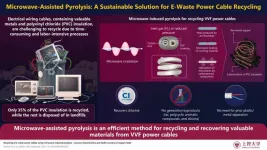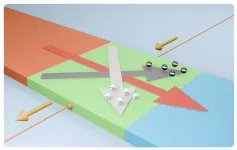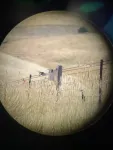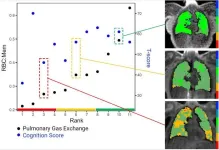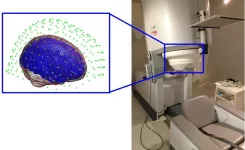(Press-News.org) UCSF Benioff Children's Hospital Oakland is enrolling patients in an innovative clinical trial that seeks to cure sickle cell disease. The trial is the first in the U.S. to apply non-viral CRISPR-Cas9 gene-editing technology in humans to directly correct the genetic mutation that causes the disease.
The research involves taking the patient’s blood stem cells to correct the mutation and returning those edited cells to the patient through a bone marrow transplant. It’s hoped the corrected blood stem cells will then multiply and create a new blood system, one free of sickle cell.
“This therapy is intended to eliminate sickle cell disease by applying CRISPR technology that is safer than a standard stem cell transplant from a healthy bone marrow donor,” Mark Walters, MD, a professor of pediatrics at UCSF and principal investigator of the clinical trial and gene editing project. “It is a potential game changer for young sickle cell patients because the therapy eliminates the need for a suitable donor and removes the mutation for a life free of sickle cell disease.”
Researchers are recruiting patients for treatment in California, beginning with up to six adults with sickle cell disease. A safety evaluation will be performed after the first three adult patients receive the treatment. If found to be safe and effective, it will expand to enroll three adolescents aged 12 to 17 years old. The trial is expected to last two years, with patients ideally being followed up for up to 15 years.
Sickle cell disease is a genetic blood disorder caused by a single mutation in both copies of a gene coding for beta-globin. Beta-globin forms half of the oxygen-carrying molecule hemoglobin. This mutation causes hemoglobin molecules to stick together, deforming red blood cells into a characteristic “sickle” shape. These misshapen cells get stuck in blood vessels, causing blockages, anemia, pain, organ failure, and a significantly shortened lifespan. Sickle cell disease affects approximately 100,000 Americans and millions worldwide, with a disproportionate effect on the Black community.
The project team from UCSF, the Innovative Genomics Institute (IGI) and UCLA have developed CRISPR_SCD001, a patient-specific blood stem cell therapy product derived from the patient that has been modified by a CRISPR-Cas9 nuclease to stimulate repair of the sickle mutation. In the current trial, the patient’s blood stem cells will be extracted and sent to UCLA’s Human Gene and Cell Therapy Facility to be processed using electrical pulses that create temporary pores in their membranes. These pores allow the non-viral CRISPR-Cas9 platform to enter the cells and travel to the nucleus, where it corrects the sickle cell mutation before the cells are returned to the patient in a bone marrow transplant procedure.
“The use of CRISPR gene editing to fix the sickle cell disease-causing mutation in each patient’s own blood-forming stem cells required the development of new methods to produce more than 100 million cells per patient that are gene-corrected, healthy and pure,” said Donald Kohn, MD, a distinguished professor of microbiology, immunology and molecular genetics and of pediatrics at UCLA. “This represents a significant increase in scale from prior research that was limited to producing 1 to 2 million genetically corrected cells.”
The trial is part of a UC research consortium led by UCSF with UCLA and UC Berkeley. It will combine CRISPR technology developed at IGI – a joint UC Berkeley-UCSF initiative founded by Nobel Laureate Jennifer Doudna – with UCLA’s expertise in genetic analysis and cell manufacturing, as well as its clinical excellence in the field, and nearly 50 years of expertise at Benioff Children’s Oakland in sickle cell care, including cord blood and marrow transplantation, and gene therapy.
“The concept for this therapy started from a conversation I had with Mark Walters around 10 years ago, so it’s gratifying to see it advance to a clinical trial,” said Doudna, PhD, the Li Ka Shing Chancellor’s Chair in Biomedical and Health Sciences at UC Berkeley. “I’m hopeful for a future with more affordable, accessible, and safer cures for sickle cell disease, and this is an important step in that direction.”
This clinical study continues BCH Oakland’s commitment to treating and finding a cure for sickle cell disease. The Comprehensive Sickle Cell Disease Center was created at the hospital in 1973 to provide expert diagnosis, treatment, and long-term health management for children and adults with sickle cell disease. Now known as the BCH Oakland Sickle Cell Center of Excellence, it is recognized as having one of the largest and most comprehensive sickle cell programs in the Western United States.
Funding: The trial is supported by the California Institute for Regenerative Medicine (CIRM), and NIH Cure Sickle Cell Initiative, National Heart, Lung, and Blood Institute (NHLBI).
About UCSF Benioff Children’s Hospitals
UCSF Benioff UCSF Benioff Children’s Hospitals are among the nation’s leading pediatric specialty hospitals, according to U.S. News & World Report 2023-24 rankings. Their expertise covers virtually all pediatric conditions, including cancer, heart disease, neurological disorders, pulmonology, diabetes, and endocrinology, as well as the care of critically ill newborns. The two campuses in San Francisco and Oakland are known for basic and clinical research, and for translating research into interventions for treating and preventing pediatric disease. They are part of UCSF Health, whose adult hospital ranks among the top medical centers nationwide and serves as the teaching hospital for the University of California, San Francisco, a national leader in biomedical research and graduate-level health/sciences education. Visit www.ucsfhealth.org.
###
END
Novel gene therapy trial for sickle cell disease launches
The study uses CRISPR to correct sickle cell mutation and aims to free patients of the disease.
2024-11-26
ELSE PRESS RELEASES FROM THIS DATE:
Engineering hypoallergenic cats
2024-11-26
Gene editing could create hypoallergenic cats, according to a sequence analysis of the protein that triggers allergies to cats. Some 15% of people are allergic to cats, and symptoms can be severe. Martin D. Chapman and colleagues investigated CH1 and CH2, genes that code for the allergen, Fel d 1. Cats produce Fel d 1 in their sebaceous, salivary, perianal, and lachrymal glands. The function of Fel d 1 is unknown but comparisons of Fel d 1 sequences and homologs from 276 domestic or exotic cats—including cougars, cheetahs, lions, tigers, and jaguars, among others—suggests that CH1 and CH2 have been under active selection, and ...
Microwave-induced pyrolysis: A promising solution for recycling electric cables
2024-11-26
The demand for electronics has led to a significant increase in e-waste. In 2022, approximately 62 million tons of e-waste were generated, marking an 82% increase from 2010. Projections indicate that this figure could rise to 82 million tons by 2030. E-waste contains valuable materials such as metals, semiconductors, and rare elements that can be reused. However, in 2022, only 22.3% of e-waste was properly collected and recycled, while the remaining materials, estimated to be worth almost $62 billion, were discarded in landfills. Although efforts to improve e-waste recycling continue, the process remains labor-intensive, and a significant portion of e-waste ...
Cooling with light: Exploring optical cooling in semiconductor quantum dots
2024-11-26
Cooling systems are an integral part of many modern technologies, as heat tends to wear down materials and decrease performance in several ways. In many cases, however, cooling can be an inconvenient and energy-intensive process. Accordingly, scientists have been seeking innovative and efficient methods to cool substances down.
Solid-state optical cooling is a prominent example that leverages a very unique phenomenon called anti-Stokes (AS) emission. Usually, when materials absorb photons from incoming light, their electrons transition into an “excited” state. Under ideal conditions, as electrons return to their original ...
Breakthrough in clean energy: Scientists pioneer novel heat-to-electricity conversion
2024-11-26
Thermoelectric materials, which convert heat into electricity, are valuable tools for capturing waste heat and turning it into usable electricity. These materials are especially useful in industries and vehicles where engines produce a lot of waste heat, improving energy efficiency by converting it into additional power. They also exhibit potential for portable power generation, in remote sensors and satellites where traditional power sources may be impractical.
Traditional thermoelectric devices, known as parallel thermoelectric devices, generate a voltage in the same direction as the heat ...
Study finds opposing effects of short-term and continuous noise on western bluebird parental care
2024-11-26
Recent research led by Kerstin Ozkan and published in PeerJ Life and Environment has uncovered the complex and contrasting effects of human-generated noise on Western Bluebird (Sialia mexicana) parental behavior, raising critical questions about how anthropogenic noise affects wildlife in both urban and non-urban settings. The study, titled “Divergent effects of short-term and continuous anthropogenic noise exposure on Western Bluebird parental care behavior,” explores how different types of noise exposure alter the bird's ...
Quantifying disease impact and overcoming practical treatment barriers for primary progressive aphasia
2024-11-26
Imagine gradually losing the ability to express yourself — not because you've forgotten the words, but because they simply won't come out. This is the reality for individuals living with primary progressive aphasia (PPA), a rare form of dementia that usually begins in middle age and increasingly impairs language abilities over time.
Researchers at the University of Chicago Medicine are working to illuminate the struggles of those living with this condition and pioneer accessible treatment models. They recently published new studies that measure PPA’s significant impact ...
Sports betting and financial market data show how people misinterpret new information in predictable ways
2024-11-26
Let’s say it’s a home game for the Golden State Warriors and Steph Curry shows he’s still got it, sinking back-to-back three-pointers minutes into the first quarter. The fans at Chase Center take notice, and so do the betting markets, where the odds move in the Warriors’ favor.
Yet it’s a long game. The away team comes back, and with just 10 seconds to go, the Warriors are down by two and have just missed a shot. A victory is unlikely, and the betting odds should have shifted to reflect that near-certainty. ...
Long COVID brain fog linked to lung function
2024-11-26
CHICAGO – In patients with long COVID, lower pulmonary gas exchange may be associated with impaired cognitive function, according to a study being presented next week at the annual meeting of the Radiological Society of North America (RSNA).
According to the National Center for Health Statistics, approximately 17.6% of adults in the U.S. have experienced a post-COVID condition commonly referred to as long COVID. People with long COVID may exhibit a wide variety of symptoms, including difficulty concentrating (“brain fog”), change in sense of smell or taste, fatigue, joint or muscle pain, dyspnea (shortness of breath), digestive ...
Concussions slow brain activity of high school football players
2024-11-26
CHICAGO – A new study of high school football players found that concussions affect an often-overlooked but important brain signal. The findings are being presented next week at the annual meeting of the Radiological Society of North America (RSNA).
Reports have emerged in recent years warning about the potential harms of youth contact sports on developing brains. Contact sports, including high school football, carry a risk of concussion. Symptoms of concussion commonly include cognitive disturbances, such as difficulty with balancing, ...
Study details how cancer cells fend off starvation and death from chemotherapy
2024-11-26
Laboratory experiments with cancer cells reveal two ways in which tumors evade drugs designed to starve and kill them, a new study shows.
While chemotherapies successfully treat cancers and extend patients’ lives, they are known not to work for everyone for long, as cancer cells rewire the process by which they convert fuel into energy (metabolism) to outmaneuver the drugs’ effects. Many of these drugs are so-called antimetabolics, disrupting cell processes needed for tumor growth and survival.
Three such drugs used in the study — raltitrexed, N-(phosphonacetyl)-l-aspartate (PALA), and brequinar ...
LAST 30 PRESS RELEASES:
Sleeping in on weekends may help boost teens’ mental health
Study: Teens use cellphones for an hour a day at school
After more than two years of war, Palestinian children are hungry, denied education and “like the living dead”
The untold story of life with Prader-Willi syndrome - according to the siblings who live it
How the parasite that ‘gave up sex’ found more hosts – and why its victory won’t last
When is it time to jump? The boiling frog problem of AI use in physics education
Twitter data reveals partisan divide in understanding why pollen season's getting worse
AI is quick but risky for updating old software
Revolutionizing biosecurity: new multi-omics framework to transform invasive species management
From ancient herb to modern medicine: new review unveils the multi-targeted healing potential of Borago officinalis
Building a global scientific community: Biological Diversity Journal announces dual recruitment of Editorial Board and Youth Editorial Board members
Microbes that break down antibiotics help protect ecosystems under drug pollution
Smart biochar that remembers pollutants offers a new way to clean water and recycle biomass
Rice genes matter more than domestication in shaping plant microbiomes
Ticking time bomb: Some farmers report as many as 70 tick encounters over a 6-month period
Turning garden and crop waste into plastics
Scientists discover ‘platypus galaxies’ in the early universe
Seeing thyroid cancer in a new light: when AI meets label-free imaging in the operating room
Neutrophil-to-lymphocyte ratio may aid risk stratification in depressive disorder
2026 Seismological Society of America Annual Meeting
AI-powered ECG analysis offers promising path for early detection of chronic obstructive pulmonary disease, says Mount Sinai researchers
GIMM uncovers flaws in lab-grown heart cells and paves the way for improved treatments
Cracking the evolutionary code of sleep
Medications could help the aging brain cope with surgery, memory impairment
Back pain linked to worse sleep years later in men over 65, according to study
CDC urges ‘shared decision-making’ on some childhood vaccines; many unclear about what that means
New research finds that an ‘equal treatment’ approach to economic opportunity advertising can backfire
Researchers create shape-shifting, self-navigating microparticles
Science army mobilizes to map US soil microbiome
Researchers develop new tools to turn grain crops into biosensors
[Press-News.org] Novel gene therapy trial for sickle cell disease launchesThe study uses CRISPR to correct sickle cell mutation and aims to free patients of the disease.
